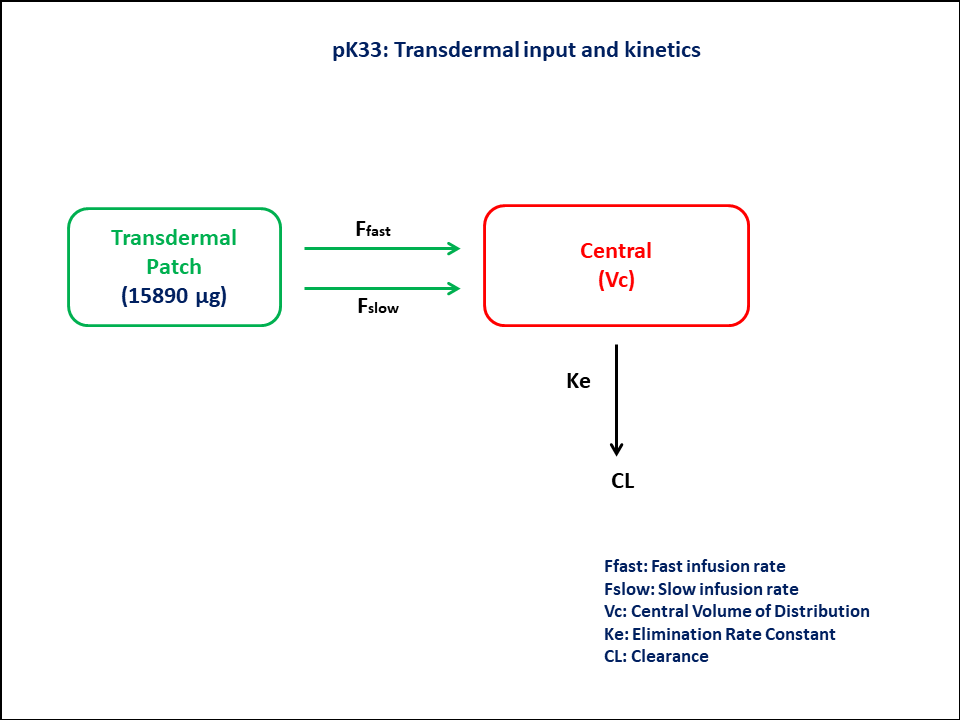using Random
using Pumas
using PumasUtilities
using CairoMakie
using AlgebraOfGraphics
using CSV
using DataFramesMeta
PK33 - Transdermal input and kinetics
1 Learning Outcome
To understand the kinetics of a given drug using transdermal input following 2 different input rates
2 Objectives
To build a one compartment model with zero-order input and to understand its function using a transdermal delivery system
3 Background
Before constructing a model, it is important to establish the process the model will follow and a scenario for the simulation.
Below is the scenario for this tutorial:
- Structural model - One compartment linear elimination with zero-order input
- Route of administration - Transdermal
- Dosage Regimen - 15,890 μg per patch. The patch was applied for 16 hours over 5 consecutive days
- Number of Subjects - 1
This diagram describes how such an administered dose will be handled, which facilitates building the model. 
4 Libraries
Call the required libraries to get started.
5 Model
This is a one compartment model with zero-order input following transdermal drug administration.
pk_33 = @model begin
@metadata begin
desc = "One Compartment Model"
timeu = u"hr"
end
@param begin
"""
Clearance (L/hr)
"""
tvcl ∈ RealDomain(lower = 0)
"""
Volume of Central Compartment (L)
"""
tvvc ∈ RealDomain(lower = 0)
"""
Dose of slow infusion (μg)
"""
tvdslow ∈ RealDomain(lower = 0)
"""
Duration of fast release (hr)
"""
tvtfast ∈ RealDomain(lower = 0)
"""
Duration of slow release (hr)
"""
tvtslow ∈ RealDomain(lower = 0)
Ω ∈ PDiagDomain(5)
"""
Proportional RUV
"""
σ²_prop ∈ RealDomain(lower = 0)
"""
Additional RUV
"""
σ_add ∈ RealDomain(lower = 0)
end
@random begin
η ~ MvNormal(Ω)
end
@pre begin
Cl = tvcl * exp(η[1])
Vc = tvvc * exp(η[2])
Dose_slow = tvdslow * exp(η[3])
Tfast = tvtfast * exp(η[4])
Tslow = tvtslow * exp(η[5])
Ffast = (t <= Tfast) * (15890 - Dose_slow) / Tfast
Fslow = (t <= Tslow) * Dose_slow / Tslow
end
@init begin
Central = 2 * Vc
end
@dynamics begin
Central' = Ffast + Fslow - (Cl / Vc) * Central
end
@derived begin
cp = @. Central / Vc
"""
Observed Concentration (μg/L)
"""
dv ~ @. Normal(cp, sqrt((cp^2 * σ²_prop) + σ_add^2))
end
endPumasModel
Parameters: tvcl, tvvc, tvdslow, tvtfast, tvtslow, Ω, σ²_prop, σ_add
Random effects: η
Covariates:
Dynamical system variables: Central
Dynamical system type: Nonlinear ODE
Derived: cp, dv
Observed: cp, dv6 Parameters
These are the initial estimates we will be using in this model exercise. Note that tv represents the typical value for parameters.
CL- Clearance (L/hr),Vc- Volume of Central Compartment (L)Dslow- Dose of slow infusion (μg)Tfast- Duration of fast release (hr)Tslow- Duration of slow release (hr)Ω- Between Subject Variabilityσ- Residual error
param = (;
tvcl = 79.8725,
tvvc = 239.94,
tvdslow = 11184.3,
tvtfast = 7.54449,
tvtslow = 19.3211,
Ω = Diagonal([0.01, 0.01, 0.01, 0.01, 0.01]),
σ²_prop = 0.005,
σ_add = 0.01,
)7 Dosage Regimen
- 15,890 μg per patch.
- The patch is applied for 16 hours, for 5 consecutive days
- The patch releases the drug at two different rate processes, fast and slow, simultaneously over a period of 6 and 18 hours respectively.
sub1 = Subject(; id = 1)Subject
ID: 18 Simulation
Since the model is created and the initial parameters are specified, one should evaluate the model. Simulating with a single subject is one way to address this.
The Random.seed! function is included here for purposes of reproducibility of the simulation in this tutorial. Specification of a seed value would not be required in a Pumas workflow that is estimating model parameters.
Random.seed!(123)sim_sub1 = simobs(pk_33, sub1, param, obstimes = 0:0.1:24)SimulatedObservations
Simulated variables: cp, dv
Time: 0.0:0.1:24.09 Visualization
@chain DataFrame(sim_sub1) begin
dropmissing(:cp)
data(_) *
mapping(:time => "Time (hours)", :cp => "Concentration (μg/L)") *
visual(Lines; linewidth = 4)
draw(; figure = (; fontsize = 22), axis = (; xticks = 0:5:25))
end10 Population Simulation
This block updates the parameters of the model to increase intersubject variability in parameters and defines timepoints for the prediction of concentrations. The results are written to a CSV file.
par = (
tvcl = 79.8725,
tvvc = 239.94,
tvdslow = 11184.3,
tvtfast = 7.54449,
tvtslow = 19.3211,
Ω = Diagonal([0.012, 0.024, 0.012, 0.01, 0.012]),
σ²_prop = 0.008,
σ_add = 0.01,
)
ev1 = DosageRegimen(15890; time = 0, cmt = 1)
pop = map(i -> Subject(id = i, events = ev1), 1:24)
Random.seed!(1234)
sim_pop = simobs(
pk_33,
pop,
par,
obstimes = [0, 0.5, 1, 2, 3, 4, 6, 8, 10, 12, 14, 16, 17, 18, 21, 23.37],
)
df_sim = DataFrame(sim_pop)
#CSV.write("pk_33.csv", df_sim)With the CSV.write function, you can input the name of the DataFrame (df_sim) and the file name of your choice (pk_33.csv) to save the file to your local directory or repository.
11 Conclusion
Constructing a transdermal one-compartment model with zero-order input involves:
- understanding the process of how the drug is passed through the system,
- translating processes into ODEs using Pumas,
- preparing the data using Pumas data wrangling functionality, and
- simulating the model in a single patient for evaluation.